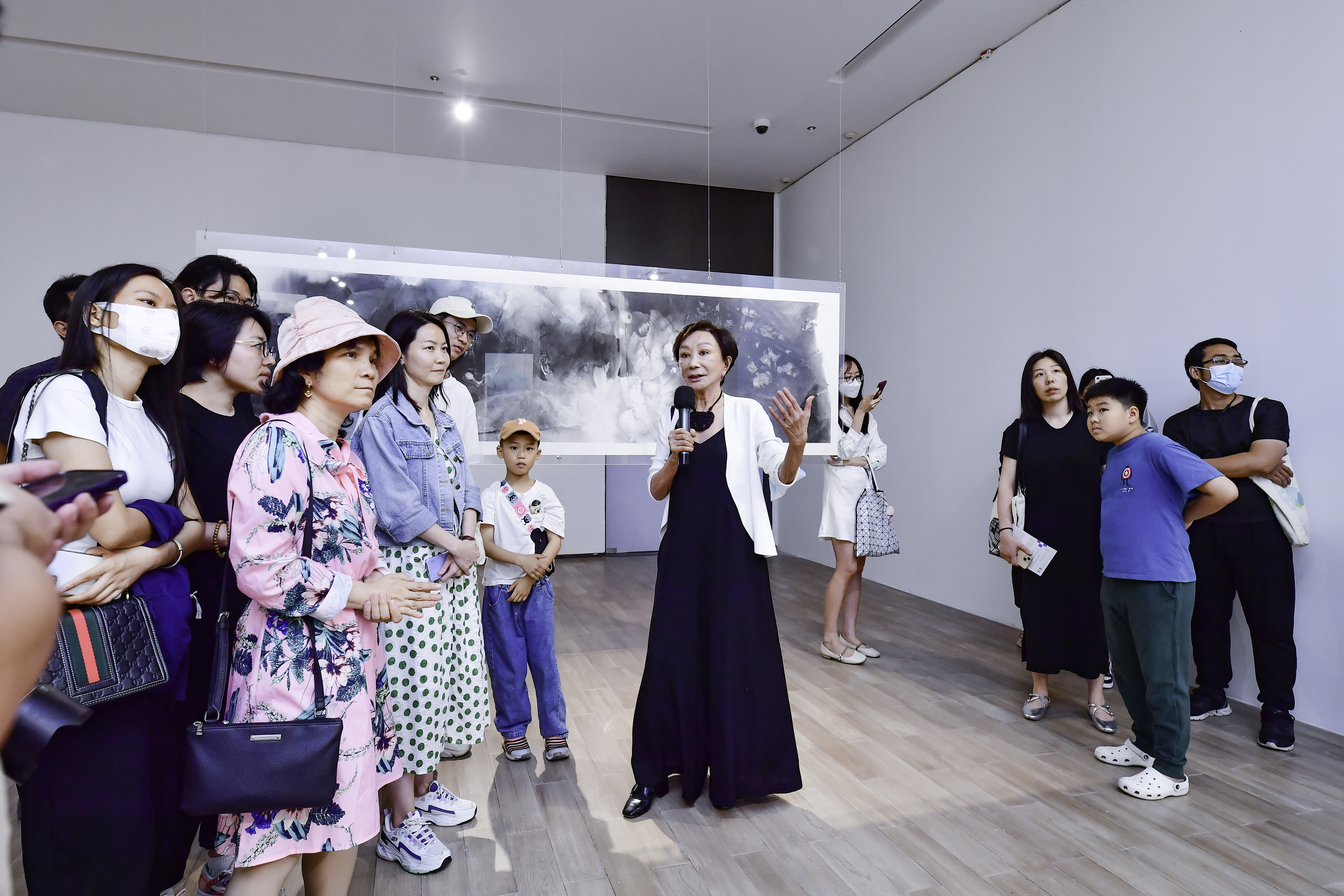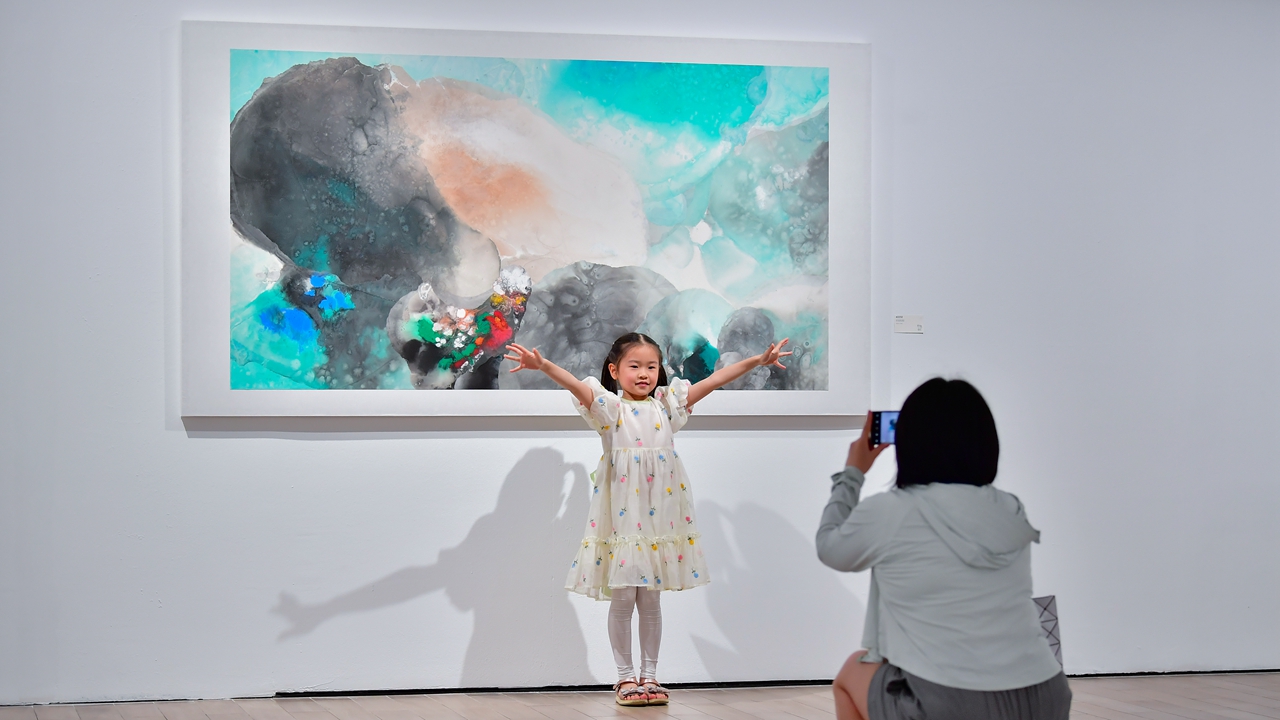Soul-searching leads to soul-healing ink paintings
An integral part of Chinese literati culture for thousands of years, the skills and styles of ink painting have remained largely unchanged. That was until the last century, when contemporary artists began elevating the style beyond its traditional origins, incorporating new mediums and concepts that make the paintings applicable to a modern context.
A female artist who stands out in this respect is Yu Lanyin, whose 61 contemporary ink paintings are on display at the Guangming Culture and Art Center until June 4.

Visitors admire Yu Lanyin’s works at her solo exhibition at Guangming Culture and Art Center.Photos courtesy of the organizer
Displayed in Hall B on the third floor of the venue, most of the paintings were created in the past three decades from her representative “Soul of Ink” series, inspired by her surreal experiences of scuba diving.
Titled “Being in the World,” the exhibition offers a soul-healing experience that echoes the proposition of German philosopher Heidegger, said co-curator Zuo Qianqian. Influenced by Taoist and Zen Buddhist thoughts, Heidegger believed in the harmonious coexistence of humans and their living environment, and proposed the “authentic existence” by realizing their own destiny and fulfilling their real potentiality in the world.

Yu Lanyin (C) explains her works to visitors at Guangming Culture and Art Center.
Using exuberant colors, Yu has created a unique style combining various techniques, including rubbing, spilling and splattering to layer her works, leading to emotional expressions that remind one of the abstract or impressionist paintings of the West.
The dreamy images conjured up in her ink paintings are reminiscent of an underwater world that’s otherworldly and perhaps exists only in Chinese legends, where colorful corals and mysterious creatures are hidden.
Art critic Robert Morgan once praised Yu’s works as stunning, which “trigger the viewer to ponder on their true identity and destiny with a feeling of loneliness and openness evoked by the light and shadows and the pulsating rhythm articulated by her images.”
Born in 1943 in Shanghai, Yu migrated with her parents to Taiwan, where she received her college education. She went to the United States to further her studies in 1964 and received master’s degrees in art and art history from the University of Louisville. After that, Yu spent many years studying with Will Barnet, a 20th-century American artist best known for his symbolic paintings and prints created in his distinctively flat, stylized aesthetic.
The pilgrimage toward art is a soul-searching and root-finding experience for Yu, who studied Chinese painting with Huang Junbi, Gao Yihong, Fu Xinshe and Sun Duoci at the tender age of 7.
“When I was very young, my father admonished me to stay loyal to myself. ‘You should only paint to serve a pure passion and that’s the way to achieve freedom,’ he said. Painting for money or fame will drain an artist of their most precious freedom,” she recalled.
Yu lost her mom at 19, whom she didn’t get the chance to accompany at the last moment. “That’s a painful experience, which haunted me for a long time,” Yu said.
It was not until she took to diving in the 1980s that she finally came to terms with the fact that her mother didn’t live to an old age. The artist then found refuge and epiphany in the ocean, a force both mysterious and formidable. “Diving taught me about the transience of life and everything. When diving, humans are at the mercy of uncertainty and nature; you can do nothing but accept it.”
“I was inspired by water, a substance that is always nurturing and tolerating another, but never competes against them — the rocks, the coral reefs, etc.,” she said. “Similarly, a person can only touch and influence others if they are humble and tolerant towards them.”
Thanks to her father Yu Junzhi being an art critic, the artist was well read in Chinese literature and philosophy from a young age. However, she said it was not until she started scuba diving that she got a better understanding of Laozi and his thoughts. “Deep at sea I came to understand the idea of becoming one with the universe. I can feel at ease and being equal with the marine life surrounding me.”
Calling herself a curious person ready to explore new experiences at any time, Yu said she hopes visitors to the show will enjoy the paintings and experience the sense of awe for the ocean that she felt while diving.
“Diving and painting is a healing experience for me personally, and I hope that experience can reach the audiences.”
The artist had exhibited extensively in the United States before settling in Zhongshan City, Guangdong Province in 1993.

Visitors at Yu Lanyin's solo exhibition at Guangming Culture and Art Center.